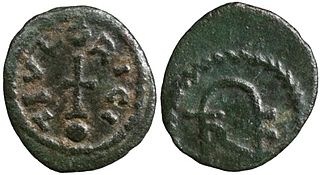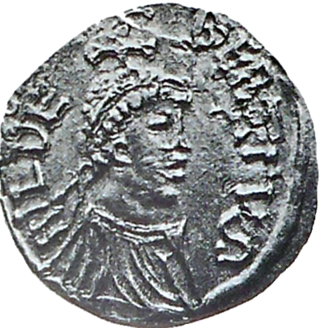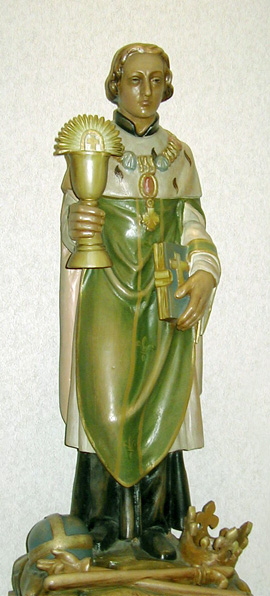The 520s decade ran from January 1, 520, to December 31, 529.

Year 511 (DXI) was a common year starting on Saturday of the Julian calendar. At the time, it was known as the Year of the Consulship of Felix and Secundinus. The denomination 511 for this year has been used since the early medieval period, when the Anno Domini calendar era became the prevalent method in Europe for naming years.
Year 524 (DXXIV) was a leap year starting on Monday on the Julian calendar. In the Roman Empire, it was known as the Year of the Consulship of Iustinus and Opilio. The denomination 524 for this year has been used since the early medieval period, when the Anno Domini calendar era became the prevalent method in Europe for naming years.

Theuderic I was the Merovingian king of Metz, Rheims, or Austrasia—as it is variously called—from 511 to 534.

Clotilde, is a saint and was a Queen of the Franks.

Austrasia was the northeastern kingdom within the core of the Frankish Empire during the Early Middle Ages, centring on the Meuse, Middle Rhine and the Moselle rivers. It included the original Frankish-ruled territories within what had been the northernmost part of Roman Gaul, and cities such as Cologne, Trier and Metz. It also stretched beyond the old Roman borders on the Rhine into Frankish areas which had never been formally under Roman rule. It came into being as a part of the Frankish Empire founded by Clovis I (481–511). At the same time, the initial powerbase of Clovis himself was the more Romanized part of northern Gaul, lying southwest of Austrasia, which came to be known as Neustria.

Chlothar II, sometimes called "the Young", was king of the Franks, ruling Neustria (584–629), Burgundy (613–629) and Austrasia (613–623).

Neustria was the western part of the Kingdom of the Franks during the Early Middle Ages, in contrast to the eastern Frankish kingdom, Austrasia. It initially included land between the Loire and the Silva Carbonaria, in the north of present-day France, with Paris, Orléans, Tours, Soissons as its main cities.

Chlothar I, sometime called "the Old", also anglicised as Clotaire, was a king of the Franks of the Merovingian dynasty and one of the four sons of Clovis I.

Childebert I was a Frankish King of the Merovingian dynasty, as third of the four sons of Clovis I who shared the kingdom of the Franks upon their father's death in 511. He was one of the sons of Saint Clotilda, born at Reims. He reigned as King of Paris from 511 to 558 and Orléans from 524 to 558.

Childebert II (c.570–596) was the Merovingian king of Austrasia from 575 until his death in March 596, and the king of Burgundy from 592 to his death, as the adopted son of his uncle Guntram.

The Kingdom of the Franks, also known as the Frankish Kingdom, the Frankish Empire or Francia, was the largest post-Roman barbarian kingdom in Western Europe. It was ruled by the Frankish Merovingian and Carolingian dynasties during the Early Middle Ages. Francia was among the last surviving Germanic kingdoms from the Migration Period era.

Sigismund was King of the Burgundians from 516 until his death. He was the son of king Gundobad and Caretene. He succeeded his father in 516. Sigismund and his brother Godomar were defeated in battle by Clovis's sons, and Godomar fled. Sigismund was captured by Chlodomer, King of Orléans, where he was kept as a prisoner. Later he, his wife and his children were executed. Godomar then rallied the Burgundian army and won back his kingdom.

Theuderic III was King of the Franks in the 7th century. He ruled Neustria and Burgundy on two occasions, as well as Austrasia from 679 until his death in 691.
Godomar II, son of king Gundobad, was king of Burgundy. He ruled Burgundy after the death of Sigismund, his elder brother, in 524 until 534.
Guntheuc was a Frankish queen consort. She was first married to King Chlodomer and later to his younger brother, King Chlothar I.

The Battle of Vézeronce was fought on 25 June 524 AD near Vézeronce-Curtin, now in Isère, France, between the Franks led by King Chlodomer and the Burgundians commanded by King Godomar.

Clodoald, better known as Saint Cloud, was a Merovingian prince, grandson of Clovis I and son of Chlodomer, who preferred to renounce royalty and became a hermit and monk. Clodoald found a hill along the Seine, two leagues below Paris, in a place called Novigentum. Here, among the fishermen and farmers, he led a life of solitude and prayer, and built a church, which he dedicated in honor of Martin of Tours.
Suavegotha, also known as Suavegotta or Suavegotho, was the daughter of the Burgundian king Sigismund and his Ostrogothic wife Ostrogotho. She was apparently married to Theuderic I, but scholars debate whether she was his first or second wife.

















